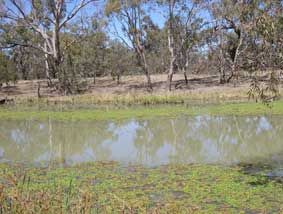Major Group: Insecta
Order: Diptera
Family: Sciomyzidae
Subfamily: Sciomyzinae
Genus: Dichetophora
Aquatic species in Australia belong to a single genus, Dichetophora. |
Descriptive Features: head capsule incomplete, without externally visible sclerotization, reduced in size and structure, often retractile into thorax
cephalic structure a "cephalopharyngeal" skeleton
mandibles usually with hooked apical tooth and lacking inner teeth
mouth-hooks united by ventral arch
thoracic segments longer and narrower than abdominal segments
abdomen 8-segmented
posterior spiracles at apices of separate diverging branches arising from common base, never spine-like
Total length: up to 5mm
|

|
Dichetophora |
|
|
|
Taxonomic Checklist: Species
Dichetophora australis Walker
Dichetophora biroi Kertesz
Dichetophora boyesi Steyskal
Dichetophora conjuncta Malloch
Dichetophora hendeli Kertesz
Dichetophora punctipennis Malloch |
|
Distribution: Australia wide
Sensitivity Rating: SIGNAL grade 2
Functional Feeding Group: predators, parasites |

|
Billabong Creek on OldCoree nr Jerilderie, NSW |
|
|
Ecology: Instream habitat: Free-living larvae and floating pupae of Dichetophora are common in ponds, dams and creeks with little flow, especially where there are populations of snails.
Feeding ecology:Larvae are predators and parasites of snails.
Habit: Free living Dichetophora larvae are burrowers. They can inflate their bodies and sometimes use this technique to drag snails from the pond bottom to the water’s surface.
Life history: Sciomyzidae are commonly known as ‘snail-killers’ as the females lay their eggs in snails and upon hatching the early instar larvae parasitize the snail. Later instars are free-living. |
| |
Information Sources: Colless & McAlpine 1991, Hawking & Smith 1997, Gooderham & Tsyrlin 2002, Evenhuis 2008, Keiper et al. 2002
Key to Species: none |
|
|
|